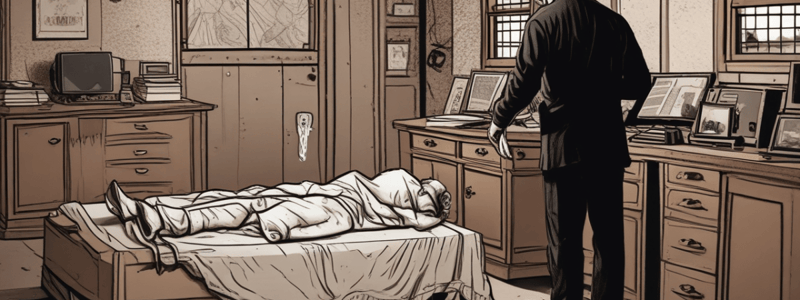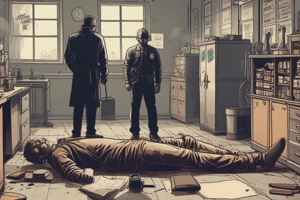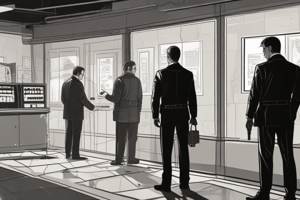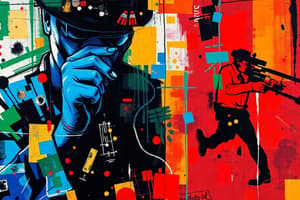Podcast
Questions and Answers
What is the primary goal of collecting evidence at a crime scene?
What is the primary goal of collecting evidence at a crime scene?
- To determine the severity of the punishment
- To understand the motives of the criminal
- To prove the suspect's guilt
- To support a successful prosecution (correct)
What is the main difference between evidence and proof?
What is the main difference between evidence and proof?
- Evidence is used in criminal cases, while proof is used in civil cases
- Evidence is information, while proof is the effect produced by that information (correct)
- Evidence is circumstantial, while proof is direct
- Evidence is allowed in court, while proof is not
What is the function of evidence in court, according to the Florida Evidence Code?
What is the function of evidence in court, according to the Florida Evidence Code?
- To prove or disprove a crime, support or undermine other evidence, and help determine an appropriate sentence (correct)
- To prove the innocence of the defendant
- To determine the credibility of the witnesses
- To prove the guilt of the suspect beyond a reasonable doubt
What type of evidence proves a fact without an inference or presumption?
What type of evidence proves a fact without an inference or presumption?
What is the purpose of the rules and concepts of evidence?
What is the purpose of the rules and concepts of evidence?
What is a crime scene?
What is a crime scene?
What is the purpose of collecting physical evidence at a crime scene?
What is the purpose of collecting physical evidence at a crime scene?
What is the role of evidence in court, according to LE911.1?
What is the role of evidence in court, according to LE911.1?
Why is it important to separate victims, complainants, and witnesses at a crime scene?
Why is it important to separate victims, complainants, and witnesses at a crime scene?
What should you ask witnesses to do at the crime scene?
What should you ask witnesses to do at the crime scene?
Why should you document the names, dates of birth, genders, races, addresses, and telephone numbers of all people involved?
Why should you document the names, dates of birth, genders, races, addresses, and telephone numbers of all people involved?
What should you do if separate rooms are not available to separate involved people?
What should you do if separate rooms are not available to separate involved people?
Why is it important to ask victims or complainants to name potential witnesses?
Why is it important to ask victims or complainants to name potential witnesses?
What should you do if witnesses try to leave the scene or remain in the background?
What should you do if witnesses try to leave the scene or remain in the background?
Why do multiple witnesses of the same event never recall the same details?
Why do multiple witnesses of the same event never recall the same details?
What should you do to prevent involved people from coordinating their accounts of what happened?
What should you do to prevent involved people from coordinating their accounts of what happened?
What is the purpose of changing gloves between collecting each piece of evidence needing DNA analysis?
What is the purpose of changing gloves between collecting each piece of evidence needing DNA analysis?
Why is it important to air-dry wet evidence before packaging?
Why is it important to air-dry wet evidence before packaging?
What type of analysis is used to examine trace evidence?
What type of analysis is used to examine trace evidence?
What is an example of a type of trace evidence?
What is an example of a type of trace evidence?
Why is it important to use breathable containers for packaging wet evidence?
Why is it important to use breathable containers for packaging wet evidence?
What is the purpose of placing each piece of evidence in its own separate container?
What is the purpose of placing each piece of evidence in its own separate container?
What is a potential source of fibers that can be transferred during a crime?
What is a potential source of fibers that can be transferred during a crime?
Why is it important to follow agency policies and procedures for evidence handling?
Why is it important to follow agency policies and procedures for evidence handling?
What is the purpose of the crime scene log?
What is the purpose of the crime scene log?
Who is responsible for documenting details in the crime scene log?
Who is responsible for documenting details in the crime scene log?
Why are officers not assigned to the crime scene not allowed to access the scene?
Why are officers not assigned to the crime scene not allowed to access the scene?
What should be included in the report if evidence becomes contaminated or altered?
What should be included in the report if evidence becomes contaminated or altered?
Who determines the crime scene jurisdiction for crime scene services?
Who determines the crime scene jurisdiction for crime scene services?
What factors determine the number and type of personnel needed to process the crime scene?
What factors determine the number and type of personnel needed to process the crime scene?
What is the purpose of assigning shifts for officers at the crime scene?
What is the purpose of assigning shifts for officers at the crime scene?
What is the role of the supervisor or investigator at the crime scene?
What is the role of the supervisor or investigator at the crime scene?
What is the first step to take when responding to fentanyl exposure at a crime scene?
What is the first step to take when responding to fentanyl exposure at a crime scene?
What is a document, in the context of questioned document evidence?
What is a document, in the context of questioned document evidence?
What is the purpose of a chain of custody?
What is the purpose of a chain of custody?
What should you do if you suspect that money found at a crime scene is counterfeit?
What should you do if you suspect that money found at a crime scene is counterfeit?
What type of information is maintained in the FCIC/NCIC database regarding counterfeit currency?
What type of information is maintained in the FCIC/NCIC database regarding counterfeit currency?
Why is it important to carefully handle documents found at a crime scene?
Why is it important to carefully handle documents found at a crime scene?
What is the purpose of document analysis?
What is the purpose of document analysis?
What should you do when you find evidence of any kind at a crime scene?
What should you do when you find evidence of any kind at a crime scene?
Flashcards are hidden until you start studying
Study Notes
The Crime Scene and Evidence
- A crime scene is the site or sites where a crime occurred, including areas or objects associated with criminal behavior.
- A crime scene can be a location, person, place, or object.
Function of Evidence
- Evidence is anything that tends to prove or disprove the existence of a fact.
- Evidence has three basic functions in court: to prove or disprove a crime, to support or undermine other evidence, and to help determine an appropriate sentence.
Types of Evidence
- There are two broad types of evidence: direct and indirect (or circumstantial).
- Direct evidence proves a fact without an inference or presumption and conclusively establishes that fact.
- The crime scene log is a document that details the name, rank, and agency of each person entering or leaving the scene, the date and time of the person's entry or exit, and the reason the person was at the scene.
Processing a Crime Scene
- Upon arrival, the supervisor or investigator will coordinate duties such as evidence collection, securing the scene perimeter, and other assignments.
- The size and type of crime scene search determine the number and type of personnel or resources needed for processing the scene.
- Agency policies, procedures, jurisdiction, and available resources will also factor into how to proceed.
Identifying Witnesses and Victims
- Ask the victim or complainant who was present during the crime or event to name any potential witnesses of the incident.
- Document the names, dates of birth, genders, races, addresses, and telephone numbers of all people involved.
- Ask vital witnesses to stay at the scene for interviewing.
Separating Involved People
- In a criminal investigation, victims, complainants, and witnesses must be kept separated to prevent them from coordinating their accounts of what happened.
- Place people in separate locations, near the crime scene area, but in a place that poses no risk of contaminating evidence.
Personal Protective Equipment (PPE) and Evidence Collection
- Depend on the type of evidence being collected, officers may need booties, facemasks, goggles, aprons, and other protective clothing or gear.
- Change PPE as often as necessary to avoid cross-contamination.
- Change gloves between collecting each piece of evidence needing DNA analysis.
Packaging and Handling Evidence
- Use proper tools, equipment, containers, and packaging to prevent contamination and degradation of evidence.
- For example, wet evidence, such as items soaked with body fluids or living plant material, must be air-dried, packaged in breathable containers, such as paper bags, or both.
- Place each piece of evidence collected for DNA analysis in its own, separate container.
Trace Evidence
- Trace evidence is small quantities of material transferred from a victim or suspect to each other or to a crime scene.
- Trace evidence can include human hair, animal hair, textile fibers and fabric, rope, feathers, soil, glass, and building materials.
Questioned Document Evidence
- A document is anything containing a mark to convey a message.
- Questioned documents need examination to verify that they could be evidence.
- Questioned documents may also contain latent fingerprints and DNA.
Chain of Custody
- When recovering evidence of any kind, begin a chain of custody to document everyone who handled the evidence as well as when, why, and what changes, if any, were made to it.
- A chain of custody documentation proves that the evidence submitted in court is the same evidence collected at the crime scene.
Studying That Suits You
Use AI to generate personalized quizzes and flashcards to suit your learning preferences.




